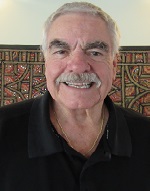Apply now to join our next cohort of Community Science Fellows and Community Leads!

Photo courtesy of Quentin C. Yates
Clairemont (or Clairemont Mesa) and Serra Mesa are communities in the city of San Diego, California, United States. Both communities border Montgomery-Gibb Executive Airport (MYF).
Clairemont has a population of about 81,600 residents, an area of roughly 13.3 square miles, and its eastern boundary is directly in the flightpath of northbound takeoffs from Montgomery-Gibbs Executive Airport The predominant topographical features are the gently rolling mesas which are separated by canyons and streams. Clairemont also has a diverse population of nationalities and religions. It is mostly residential, but also has several commercial/retail areas, mostly along the main streets, as well as many parks and open spaces throughout the community. The public educational facilities in Clairemont include twelve elementary schools, two middle schools, and two senior high schools.
Serra Mesa has a population of approximately 24,000 people and its northern boundary of single-family homes is located only a city block from the entrance to Montgomery-Gibbs Executive Airport. One of the six Serra Mesa elementary schools is within a half-mile radius of the airport and is located under the takeoff pattern of east and southbound planes, and touch and go flight school operations. Two private schools are located even closer to the airport boundary. Serra Mesa is mostly residential but has many businesses as well as Rady Children’s Hospital, Ronald McDonald House of San Diego, Sharp Memorial Hospital, and Sharp Mary Birch Hospital for Women & Newborns.
Montgomery-Gibbs Executive Airport (MYF) is a municipal airport, located in the heart of San Diego surrounded by residential communities, and has about 200,000 take-offs and landings a year. Airplanes use the most fuel on take-offs. Since the path for low flying departing flights is directly over homes, schools, places of worship, and businesses in Clairemont and Serra Mesa, they are directly exposed to a higher level of lead from the combustion of leaded aviation fuel than other surrounding communities. There are several flight schools at MYF that fly in circles for practice take-offs and landings.
As only leaded fuel is available to the General Aviation (GA) planes at MYF, they primarily drop 1.442 metric tons of lead a year on these two communities, however other nearby neighborhoods are also affected.
Montgomery Gibbs Environmental Coalition has been concerned for years about exposure to lead contamination linked to the MYF airport. The facts regarding the amount of lead drop have been presented to the government agencies and fuel suppliers, although not gaining much traction.
The community would like professional, scientific assistance in obtaining air and soil samples to determine the extent of the lead contamination due to the leaded aviation fuel usage. The project would also include mapping the footprint of the lead dropped by single piston planes and it’s the distribution on the surrounding communities. This information is intended to support their argument of reducing lead contamination by offering unleaded UL94 aviation fuel at the municipal airports.
Project Impact: With the information collected through the duration of the project, the community hopes to have productive conversations with local elected officials about the lead deposition as well as launch a community education campaign about exposures in the long term. The additional concerns of noise and safety will also be covered in the education campaign, once the results of this project create a strong foundation for their interactions with the elected officials.
The community would like help in determining the extent and impact of the lead deposition due the leaded aviation fuel usage, developing strategies to create awareness about the harmful effects, and provide solutions that help the airport and the community.
Thriving Earth Exchange projects are not funded, and all participants are volunteers.
 Quentin C. Yates is President of the Montgomery-Gibbs Environmental Coalition (MGEC). Quentin has been involved in environmental activism over the past several decades. He has been associated with organizations like Sierra Club, Residents Against Airport Noise (RAAN), Clairemont Community Planning Group, and the Clairemont Town Council. Quentin received a Bachelor of Science degree in Business Management from San Diego State University and has worked in Community Association Management for 35 years. Aside from managing Master Planned Communities, he was the Regional Manager in South County for a major San Diego Management Company. He was also the General Manager for two different downtown high-rises. He has achieved the highest state credential, Certified Community Manager, (CAM), from the California Association of Community Managers and the highest national credential Professional Community Association Manager, (PCAM.). Quentin also served in the US Navy from 1965 – 1969 and in Vietnam.
Quentin C. Yates is President of the Montgomery-Gibbs Environmental Coalition (MGEC). Quentin has been involved in environmental activism over the past several decades. He has been associated with organizations like Sierra Club, Residents Against Airport Noise (RAAN), Clairemont Community Planning Group, and the Clairemont Town Council. Quentin received a Bachelor of Science degree in Business Management from San Diego State University and has worked in Community Association Management for 35 years. Aside from managing Master Planned Communities, he was the Regional Manager in South County for a major San Diego Management Company. He was also the General Manager for two different downtown high-rises. He has achieved the highest state credential, Certified Community Manager, (CAM), from the California Association of Community Managers and the highest national credential Professional Community Association Manager, (PCAM.). Quentin also served in the US Navy from 1965 – 1969 and in Vietnam.
Maitreyee Doshi is a Project Engineer working on utility-scale solar projects. Prior to working in the utility-scale solar sector, she worked as a residential solar designer. She also also volunteers in various STEAM events with the local school districts. Maitreyee received her B.Tech in Electronics and Instrumentation from Vellore Institute of Technology and a P.S.M degree in Solar Energy Engineering and Commercialization from Arizona State University. In her free time, Maitreyee enjoys reading, hiking, and is currently learning to play the violin.
 Dr. Eddy Cadet is a professor of Environmental Science in the Earth Science Department at Utah Valley University where he has been teaching environmental courses (Environmental Health, Environmental Toxicology, Site investigation, Land Use Planning…) for over 20 years. He earned his PhD at Tuskegee University in Integrative Bioscience, his M.S. in Environmental Science also at Tuskegee University, and his B.S. in Biology at the University of Illinois, Chicago Campus. In addition to teaching environmental courses, Dr. Cadet is also involved in environmental research. His research interests include biogeochemistry of trace elements in amended soil and sediments, trace metal uptake by plants, phytoremediation, water quality and environmental pollution. Dr. Cadet is active in enforcement of Environmental Health regulations, having worked with Health Departments in Illinois and Utah for more than 20 years.
Dr. Eddy Cadet is a professor of Environmental Science in the Earth Science Department at Utah Valley University where he has been teaching environmental courses (Environmental Health, Environmental Toxicology, Site investigation, Land Use Planning…) for over 20 years. He earned his PhD at Tuskegee University in Integrative Bioscience, his M.S. in Environmental Science also at Tuskegee University, and his B.S. in Biology at the University of Illinois, Chicago Campus. In addition to teaching environmental courses, Dr. Cadet is also involved in environmental research. His research interests include biogeochemistry of trace elements in amended soil and sediments, trace metal uptake by plants, phytoremediation, water quality and environmental pollution. Dr. Cadet is active in enforcement of Environmental Health regulations, having worked with Health Departments in Illinois and Utah for more than 20 years.
(c) 2024 Thriving Earth Exchange